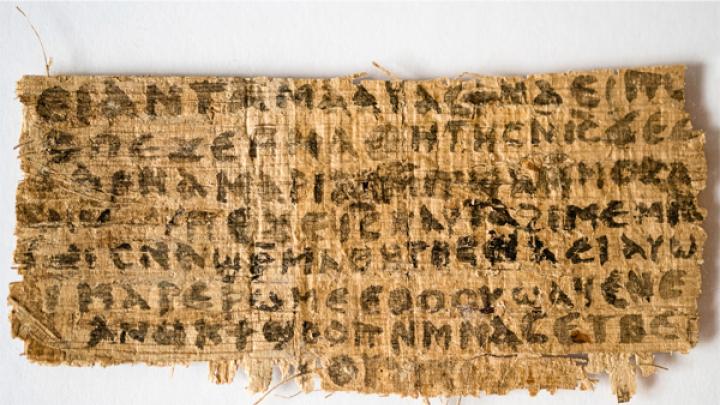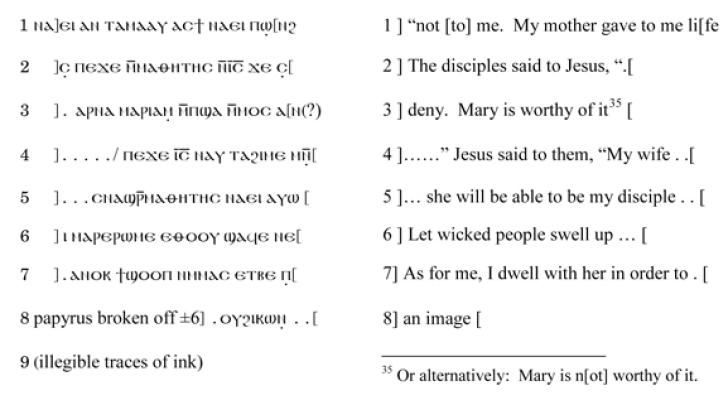In September 2012, Hollis professor of divinity Karen L. King made international headlines when she revealed the existence of a fragmentary, apparently ancient, text in which Jesus refers unequivocally to “my wife.” Even though the scholarly claim for the discovery was simple—that this constituted evidence that early Christians were engaged in debate over whether Jesus was married, and whether women (who were wives and mothers rather than virgins or celibates) could be his disciples, as opposed to evidence that a historical Jesus was actually married—controversy ensued. Some scholars declared the “Gospel of Jesus’s Wife” (GJW) a forgery, while others who had examined the text closely allowed that it appeared authentic. Late-night television had a field day.
Now the scientific dating of the papyrus and analysis of the ink (which is not ink at all, but rather lampblack, a pigment often used in ancient Egypt for writing on papyrus) indicate that both are consistent with an ancient origin.
Because the fragment is so small, carbon-dating it proved troublesome. Researchers at the University of Arizona called into question their own results—which dated the papyrus to several hundred years before the birth of Christ—because they were unable to complete the cleaning process on the small sample of papyrus with which they were working, and felt that might have led to spurious results. A second carbon-dating analysis undertaken by Clay professor of scientific archaeology Noreen Tuross at Harvard and the Woods Hole Oceanographic Institute dated the papyrus, and a separate one (also believed to be of ancient origin) with text from the Gospel of John to approximately A.D. 700 to 800.
Because the text concerning Jesus’s wife is written in Sahidic, a language of ancient Egypt, it may be a transcription of an earlier Coptic text that was based on a Greek copy, as many early Christian gospels are. Given similarities in wording and subject to the Gospel of Thomas, the Gospel of Mary, and the Gospel of Philip, the text of the GJW may originate in a time as early as the second half of the second century C.E.
The April 2014 issue of the Harvard Theological Review (HTR) includes King’s article (originally slated to be published in January 2013) discussing the fragment and its importance to understanding early Christian debates about whether wives and mothers could be disciples of Jesus. The issue also contains a counterpoint by professor of Egyptology and ancient Western Asian studies Leo Depuydt of Brown University, who writes that he is certain that the text is a modern forgery. Depuydt’s analysis, which predates the scientific findings, points out that a forger could have written with lampblack on ancient papyrus. Infrared microspectroscopic analysis of the ink and papyrus, however, found nothing to suggest that they had been “fabricated or modified at different times.” In a rebuttal, King finds Depuydt’s textual analysis unpersuasive.
The discovery of previously unknown ancient Christian texts is not unprecedented: a book called the Berlin Codex was discovered at the end of the nineteenth century; a significant collection of Coptic writings was discovered at Nag Hammadi in 1945; and the Tachos Codex was published in the early 1990s. According to an online Q and A at the Harvard Divinity School website, “These works are valuable in providing evidence for a fuller and more accurate history of the diverse forms, practices, and ideas held by Christians in the earliest centuries after the death of Jesus.”
King herself reflects in HTR on the significance of the discovery:
The most historically reliable early Christian literature is silent about Jesus’s marital status, and the GJW fragment does not change that situation. It is not evidence that Jesus was married, but it does appear to support the favorable position on marriage and reproduction taken by the canonical 1 Timothy, and it stands on the side of Jesus as he refutes the statement of Peter in Gos. Thom. 114 that “women are not worthy of life.” Although we cannot know whether this damaged fragment supported the ancient patriarchal household order or argued that females should become male as these writings do, it does seem to enter debates over whether Jesus’s incarnate life pointed toward marriage or celibacy as the ideal mode of Christian life. Ultimately such questions raise theological issues of whether sexuality belongs to being fully human or necessarily compromises holiness. In my reading, however, the main point of the GJW fragment is simply to affirm that women who are wives and mothers can be Jesus’s disciples.
The anonymous, private collector who owns the GJW fragment has offered to loan it to Harvard on a long-term basis so that scholars will have unfettered access to it, and Harvard is reportedly considering the offer.










